Homeowners that are not connected to a natural gas pipeline often use gas tanks or propane-butane cylinders as a fuel source. Alignment of operating indicators is carried out using special fittings - gas propane reducers, which, if necessary, reduce the pressure in the cylinder and maintain it at a given level.
In order for the equipment to be in good working order, you should know the rules for calibrating gas cylinder reducers, as well as observe the requirements for the installation and operation of devices. Consider issues related to the use of propane devices, as well as control over them.
The content of the article:
-
The need to use gas reducers
- Device, principle of operation and types
- Safe operation rules
-
Calibration of pressure gauges on gas cylinders
- The device and purpose of the flow meter
- Frequency and order of verification
- Conclusions and useful video on the topic
The need to use gas reducers
Without installing a special device - reducer - the pressure in the autonomous gas network loses its stability and changes depending on the filling of the cylinder and the composition of the fuel. To prevent this from happening, a device with a flow meter-manometer is installed, according to the readings of which it is possible to judge the operating pressure.
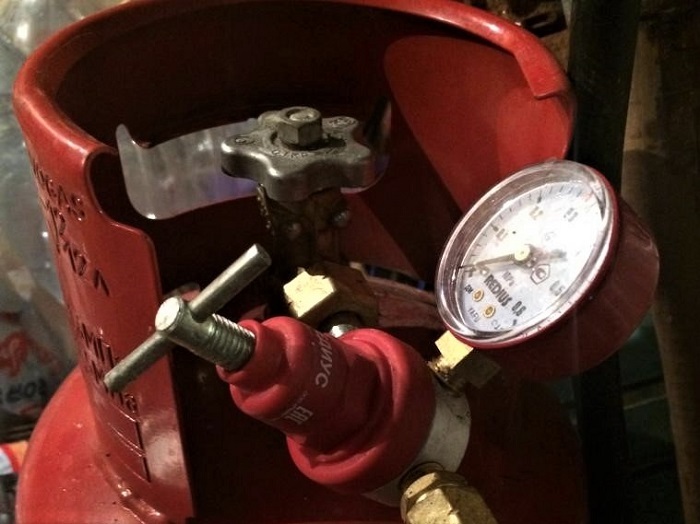
Reducers are installed on containers with different types of gas. For domestic purposes, cylinders with a propane-butane mixture are used, and it is the propane models that should be purchased.
The regulating equipment requires maintenance and from time to time undergoes verification, which is carried out by representatives of the service organization - the service of Gorgaz or Oblgaz.
Homeowners are not allowed to calibrate gas reducers, but can control the actions of workers, therefore, we will analyze in order all the important points - from the design of the device to the frequency of calling gas workers.
Device, principle of operation and types
The design of the gearbox is simple, but its production is based on high precision manufacturing of all elements.
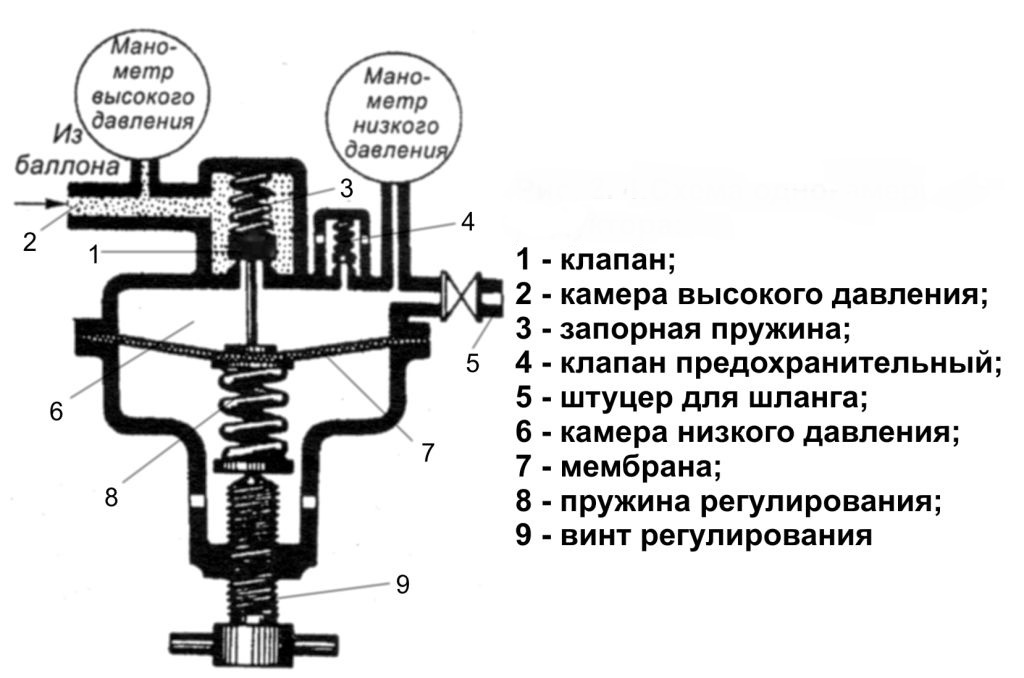
Scheme of a single-chamber reducer with two pressure gauges to monitor changes in parameters, and an adjusting screw to reduce operating pressures
The devices may vary from manufacturer to manufacturer, but the basic parts of the design remain the same.
Details of the propane device:
- metal or polymer housing;
- connecting branch pipe with union nut;
- working branch pipe with thread;
- filter unit;
- two chambers, between which the membrane is located;
- valve with a seat on the stem;
- two springs - master and return;
- pressure gauge.
There are two types of propane reducers: 1-stage and 2-stage. The difference lies in the method of reducing the pressure: in a one-stage process, the process takes place in one stage, in a two-stage process - in two. The structural difference of the second one is in the presence of a high-pressure chamber and an additional valve.
It is advisable to use a two-stage device for cylinders that have high inlet pressure, but in everyday life, single-stage models are more often used.
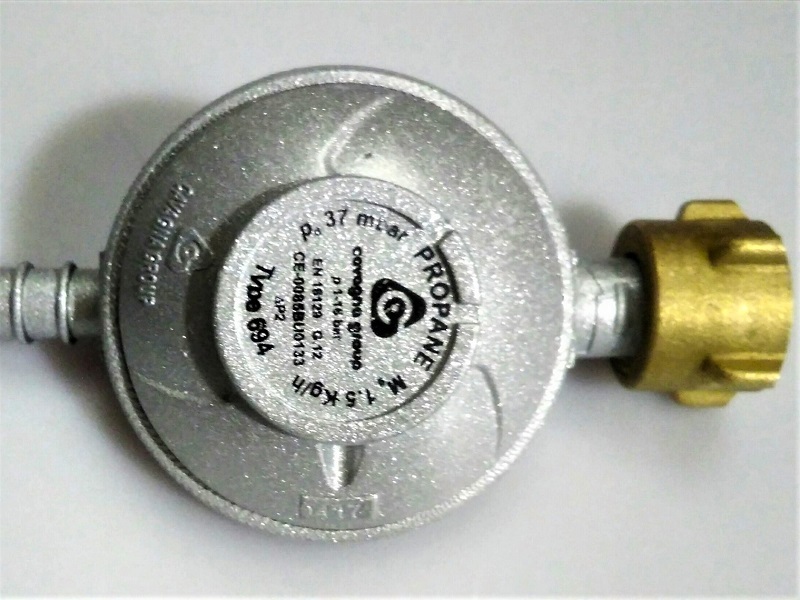
The characteristics are indicated on the gearbox housing. The stamp is applied with indelible paint at the factory, the information includes the pressure limit parameters, productivity, release date, type of gas
To distinguish a propane device from an oxygen or others, it is marked in red, but there are also metallic devices.
The principle of operation is to regulate the pressure. Passing through the nozzle into the high-pressure chamber, the gas presses on the membrane. The valve opens by means of a spring and passes fuel into the next compartment - the low pressure chamber.
There, the gas acts on the membrane from the other side, as a result of which the pressure acquires operating parameters. As soon as this happens, the valve closes. The process repeats as the parameters change.
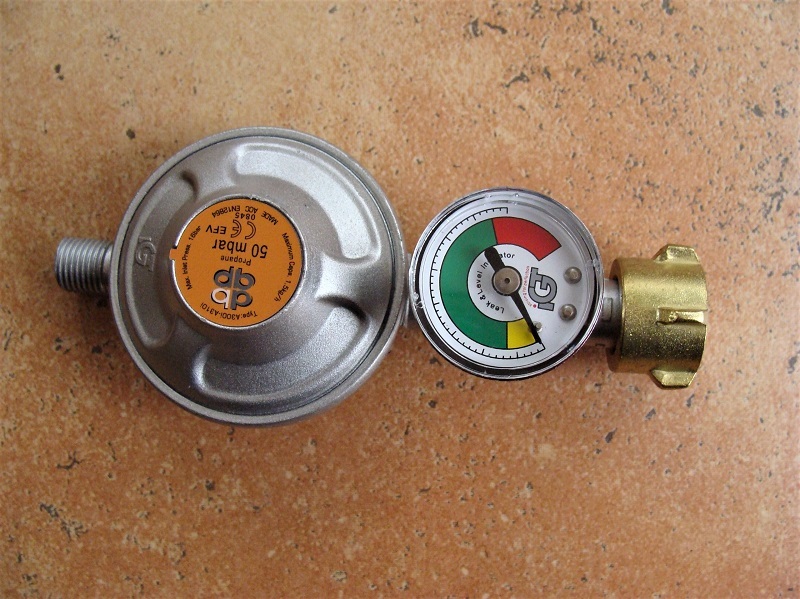
When choosing an adapter, it is necessary to take into account characteristics such as work. temperature, maximum and operating pressure, gas consumption, connection method
The connection to the gas line leading to the gas stove is made through the inlet pipe. For household cylinders, devices with a nipple outlet with a typical diameter of 6.3 mm are produced. They are cheaper than gearboxes for welding equipment.
Safe operation rules
According to the instructions for the safe operation of pressure regulators for gas cylinders, a number of rules must be observed. Before using the device, you need to make sure that it is in good working order and be sure to check the verification date. If more than a year has passed since the last calibration, the equipment cannot be used - you must contact the technical service and call a specialist.
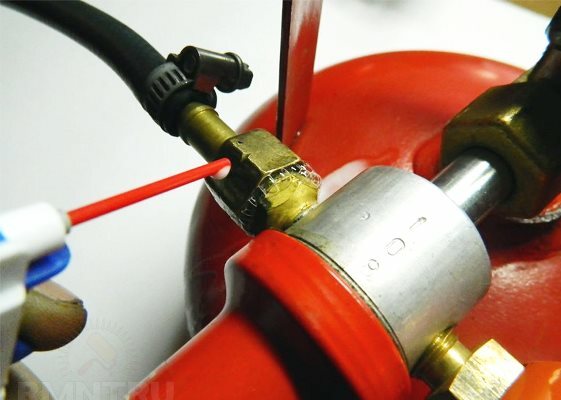
You also need to check whether the adjusting screw is working well, and whether there has been a leakage of the connections during the downtime. The easiest way to self-check is with a soapy solution.
It is allowed to enter the adapter only with a working manometer (or manometers). Open to check cylinder valve and follow the arrows on the devices. The working pressure is set based on the readings of the low pressure gauge. Turn the screw slowly to adjust.
When the valve is closed, the operating parameters cannot be set. The high pressure gauge readings come in handy when you want to know if there is propane in the cylinders.
Sometimes there are troubles in which you should urgently call the emergency gas service, but some activities can be carried out independently. If the reducer freezes, it is warmed up with steam or hot water, after having closed and insulated the cylinder.
If you are leaving home for a long time, the gas must be cut off - turn the shutter installed inside the house and be sure to tighten the cylinder valve.
You cannot perform the following actions:
- carry out welding work near existing gas equipment;
- check the tightness with an open fire - a lighter or a match;
- heat frozen fittings with open fire;
- install gearboxes for other purposes - for example, for oxygen or acetylene cylinders;
- use pressure gauges with unsuitable technical characteristics;
- use unverified, faulty manometers.
If devices or connections have visible mechanical damage, we do not recommend using a stand-alone network - you should call a specialist who will check the suitability of the equipment and give a positive conclusion.
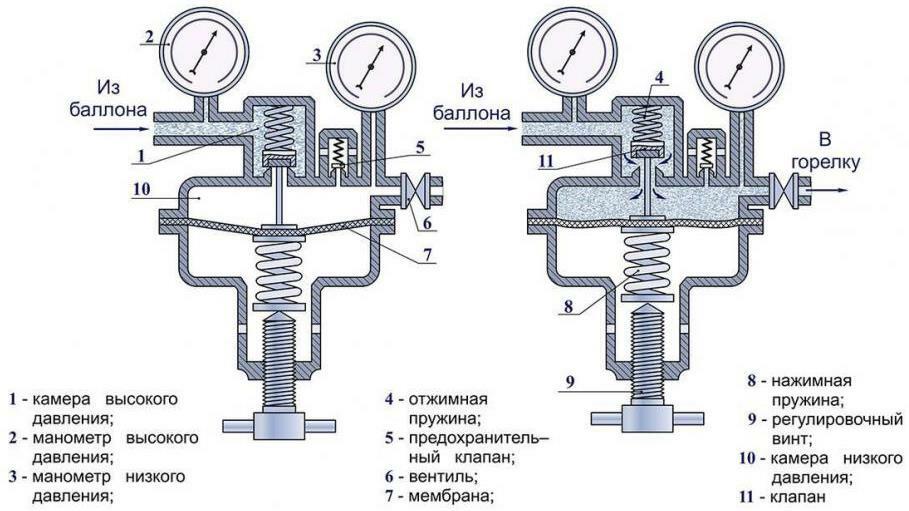
If the functionality of the gearbox has been disrupted and it began to spontaneously leak gas, it must be removed and repaired. Malfunctions often occur when the valve is no longer snug against the seat
The rules for the safe operation of gas appliances can be found in PB 03-576-03.
Calibration of pressure gauges on gas cylinders
When they talk about checking gearboxes, they really mean checking pressure gauges for household gas cylinders. Let's open a secret: reducers are not indicated in the state register of the SI of the Russian Federation, but pressure gauges are just present. And when specialists come, they check the operation of the flow meters - in the same way as they produce verification of gas meters.
But it is also necessary to monitor the functioning of the gearbox, since these two devices work in one bundle. The failure of one of the elements will immediately affect the operation of the entire system.
The device and purpose of the flow meter
Manometers are installed on household gearboxes that meet the requirements GOST 2405-88. The main purpose of the instruments is to control the pressure in the gas system. To accurately set the operating parameters, two devices are used - at the input and at the output.
The flowmeter design consists of the following elements:
- durable metal case, covered with glass on one side;
- scale with units of measurement - Pa, MPa, kgf / cm²;
- an arrow painted in a bright color;
- a sensitive element located inside the housing and driving the arrow.
The element responsible for the rotation of the arrow may differ. For a low-pressure environment, diaphragm devices are used, but spring models are more often used for gas networks - the arrow moves by reducing or straightening the spring.
To make it easier for the user to navigate and adjust the parameters as needed, a red line is drawn on the scale - just opposite the working pressure marks.
Some rules of installation and operation:
Image gallery
Photo from
Reducers with pressure gauges are installed on each cylinder or set of cylinders. The place of installation is between the stop valves of the gas cylinder and the pipeline. For connection use special fittings
The accuracy class is defined by regulatory requirements: at work. pressure above 2.5 MPa - 1.5, at work. pressure up to 2.5 MPa - 2.5
It is necessary to use such pressure gauges for which the measurement limit is working. pressure is in the second third of the scale, that is, in the middle
Measuring instruments are installed so that the glass is in the field of view, and the scale and arrow are clearly visible
Direct acting pressure gauge on propane reducer
Accuracy class of pressure gauges for reducer
Scale for determining the working pressure
Manometer readings are available to the inspector
By color coding, household pressure gauges for gas reducers differ from similar equipment for other types of gas. If oxygen fittings are painted blue, ammonia fittings yellow, acetylene fittings white, devices for propane-butane cylinders are only red.
Frequency and order of verification
Any gas equipment is subject to regular verification, even if it is not used or used seasonally, in the summer.
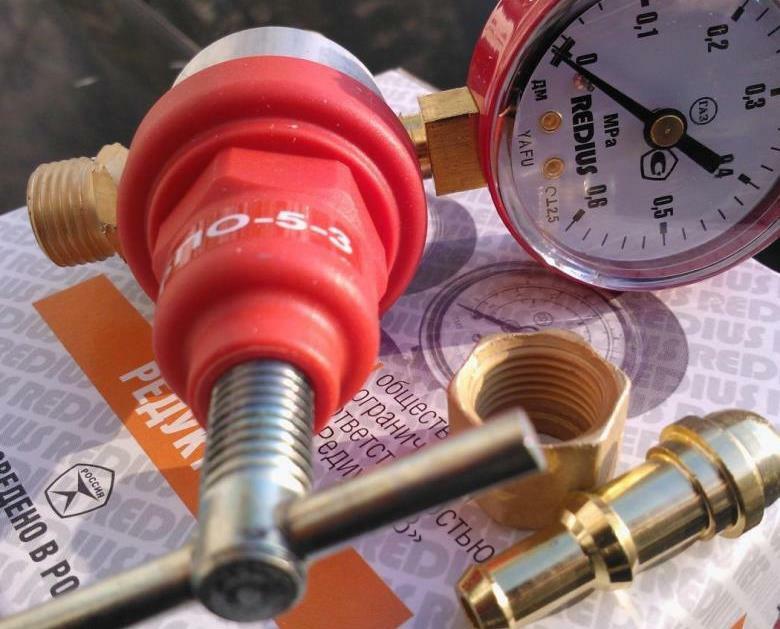
According to the norms, there is an initial verification - before commissioning or after repair. The rest of the activities are carried out periodically, on a planned basis or after an accident.
Only accredited or licensed organizations can perform verification. In our country, these are most often companies that are somehow connected with Gazprom, the main gas supplier. The obligation of the owner of the home in which the gas cylinders are installed is to issue a call on time and monitor the visit of a specialist.
Based on the results of the verification, a mark is put or a certificate is issued, which must be kept until the next procedure. A special sign is usually applied to the body of the device, and if it is not possible, then they put it directly on the certificate.
The requirements for the mark or documentation, as well as the procedure for verification, are determined by the federal executive body.
It is very important not to violate the terms: gauges are checked and a seal (stamp) is installed every 12 months.
If there is no stamp or seal on the pressure gauge, they forgot to call a representative of the service organization in time, "behavior" the arrows do not correspond to the real situation or obvious mechanical damage is visible - the gas stove must not be operated!
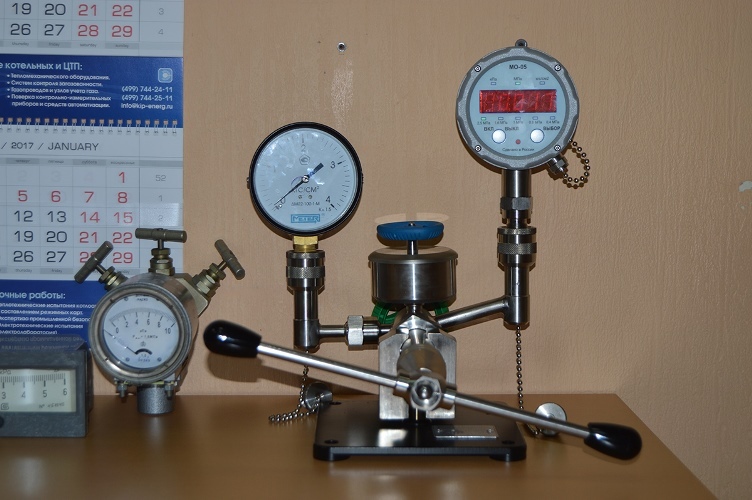
At industrial facilities, every six months, they make an additional check of the equipment's serviceability with a control pressure gauge, after which they make an entry in the log. The order, frequency, terms are indicated in the instructions for the safe maintenance of cylinders
The requirements for equipment used for hot work are much stricter. For example, gas regulators for propane cylinders are checked quarterly, and hoses every 3 months.
Conclusions and useful video on the topic
What to watch out for when buying cylinders:
Self-repair recommendations:
Only serviceable gas equipment can ensure the comfort and safety of home owners. Regular checks are another way to protect citizens from accidental accidents, therefore, the requirements of the gas service must be treated with attention and responsibility.
In the case of gas pressure regulators, once a year, invite a specialist to check the pressure gauges, and, if necessary, replace or repair the equipment.
You can take part in the discussion, leave comments on the material, share your experience or ask questions of interest to our specialists - the communication block is located under the article.


